园林英文介绍日本园林(Japenese Garden)
日本园林_精品文档

大德寺(だいとくじ)创建于日本镰 仓年间(公元1325年),位于今日本 国京都市北区,是洛北最大的寺院, 也是禅宗文化中心之一,其中尤以茶 道文化而闻名。
日本京都大德寺
Japan Kyoto Dade Temple
大德寺大仙院
由古岳禅师在16世纪设计的大德寺大仙院的方丈东北庭,通过巧妙 地运用尺度和透视感,用岩石和沙砾营造出一条“河道”。
细部处理 Detail processing
庭院在细部处理 上也做得十分成 功。例如,各种 不同寓意的石灯 笼和手水钵,还 有飞石、延段、 角飞石和自然石 飞石等人工加工 的材料使用在园 中
桂离宫庭院天之桥立
桂离宫庭园池岸飞石
总结 Summary
桂离宫的整体布局,是许多优秀建筑经过严密的构 思设计组织在一起的。其中的茶室是古茶室之一, 分春、夏、秋、冬 4间,与天然景观和谐地结合在 一起。。
③茶庭,更确切的名称是“露地”。
Tea gardens, more precise name is “open field”.
日本园林的特点(The characteristics of the Japanese garden)
• 1 源于自然 ,匠心独运。 From nature, imaginative.
日本园林的类型(The type of the Japanese
garden )
• 从形式上说,日本园林有三种主要类型: ① 池泉庭园:以水为主题 Chi-chuen garden: the theme of water. ②枯山水庭园,是以白沙代替水来造景。
Dry landscape garden, is a white sand instead of water to landscaping.
介绍日本景点英文作文
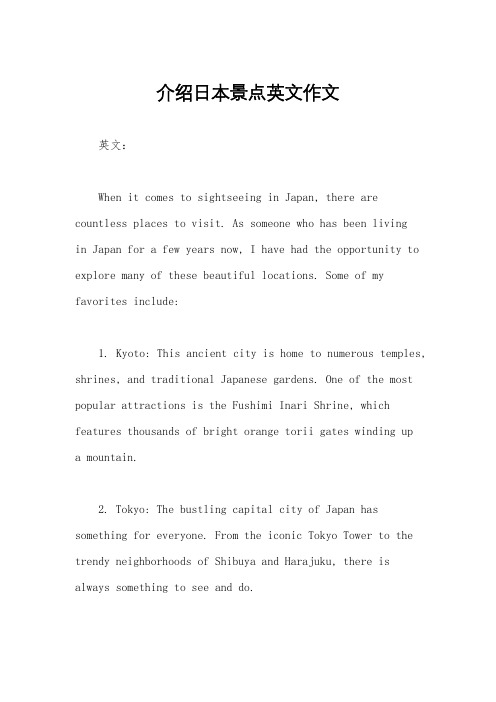
介绍日本景点英文作文英文:When it comes to sightseeing in Japan, there are countless places to visit. As someone who has been livingin Japan for a few years now, I have had the opportunity to explore many of these beautiful locations. Some of my favorites include:1. Kyoto: This ancient city is home to numerous temples, shrines, and traditional Japanese gardens. One of the most popular attractions is the Fushimi Inari Shrine, which features thousands of bright orange torii gates winding upa mountain.2. Tokyo: The bustling capital city of Japan has something for everyone. From the iconic Tokyo Tower to the trendy neighborhoods of Shibuya and Harajuku, there is always something to see and do.3. Hiroshima: While the city is known for its tragic history, it is also home to the beautiful Miyajima Island and Itsukushima Shrine. The island is famous for itsfloating torii gate, which appears to be floating on the water during high tide.4. Hokkaido: This northern island is a nature lover's paradise. From skiing in the winter to hiking in the summer, there is no shortage of outdoor activities. The city of Sapporo is also famous for its beer and snow festival.中文:说到日本的旅游景点,有很多值得一去的地方。
东京新宿御苑英语介绍
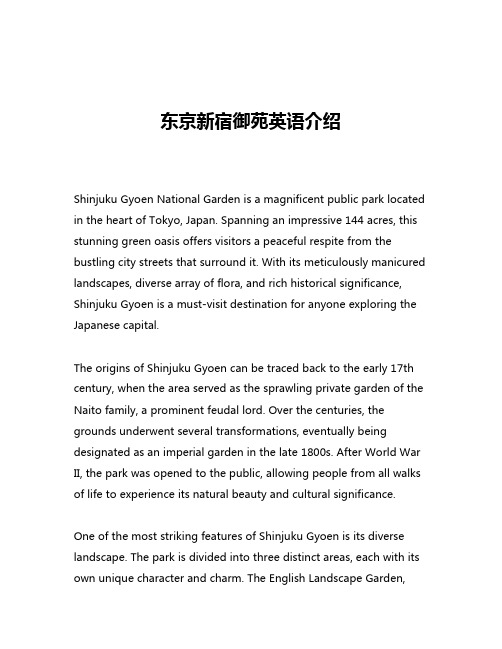
东京新宿御苑英语介绍Shinjuku Gyoen National Garden is a magnificent public park located in the heart of Tokyo, Japan. Spanning an impressive 144 acres, this stunning green oasis offers visitors a peaceful respite from the bustling city streets that surround it. With its meticulously manicured landscapes, diverse array of flora, and rich historical significance, Shinjuku Gyoen is a must-visit destination for anyone exploring the Japanese capital.The origins of Shinjuku Gyoen can be traced back to the early 17th century, when the area served as the sprawling private garden of the Naito family, a prominent feudal lord. Over the centuries, the grounds underwent several transformations, eventually being designated as an imperial garden in the late 1800s. After World War II, the park was opened to the public, allowing people from all walks of life to experience its natural beauty and cultural significance.One of the most striking features of Shinjuku Gyoen is its diverse landscape. The park is divided into three distinct areas, each with its own unique character and charm. The English Landscape Garden,inspired by the picturesque gardens of the United Kingdom, features meandering paths, serene ponds, and lush greenery. The Formal French Garden, on the other hand, is characterized by its symmetrical design, ornate fountains, and neatly trimmed hedges, offering a glimpse into the elegance of European garden design.Perhaps the most captivating section of the park, however, is the Traditional Japanese Garden. This area is a true testament to the intricate craftsmanship and profound reverence for nature that is so deeply ingrained in Japanese culture. Visitors can wander through a serene landscape of carefully pruned trees, carefully placed stones, and tranquil ponds, all designed to evoke a sense of harmony and balance.One of the true highlights of Shinjuku Gyoen is the breathtaking display of seasonal flowers that grace the park throughout the year. In the spring, the park is transformed into a sea of delicate cherry blossoms, drawing visitors from around the world to witness the enchanting sight. As summer arrives, the landscape is adorned with vibrant azaleas and vibrant irises, while the autumn brings a stunning display of fiery red and golden leaves. Even in the winter, the park maintains its allure, with the carefully sculpted trees and serene ponds providing a calming respite from the colder temperatures.Beyond its natural beauty, Shinjuku Gyoen is also rich in cultural andhistorical significance. The park's grounds are dotted with several important structures, including the Akashi Shrine, which is dedicated to the spirits of the Tokugawa clan, and the Racquets Club, a former imperial recreation facility. Visitors can also explore the park's elegant greenhouses, which house a diverse collection of exotic plants and flowers from around the world.One of the most captivating aspects of Shinjuku Gyoen is the sense of tranquility and serenity that pervades the entire park. Despite its location in the heart of one of the world's most populous cities, the park manages to create a sense of timelessness and escape, allowing visitors to truly immerse themselves in the beauty of nature. Whether strolling along the winding paths, admiring the stunning floral displays, or simply finding a quiet spot to sit and reflect, Shinjuku Gyoen offers a truly restorative experience.In conclusion, Shinjuku Gyoen National Garden is a true gem of Tokyo, offering visitors a unique opportunity to experience the natural beauty and cultural richness of Japan. From its meticulously manicured landscapes to its historical significance, this park is a testament to the enduring power of nature to provide solace, inspiration, and respite from the demands of modern life. Whether you are a first-time visitor to Tokyo or a seasoned local, a trip to Shinjuku Gyoen is sure to leave a lasting impression and create memories that will endure long after your visit.。
关于园林专业的一些外语词汇
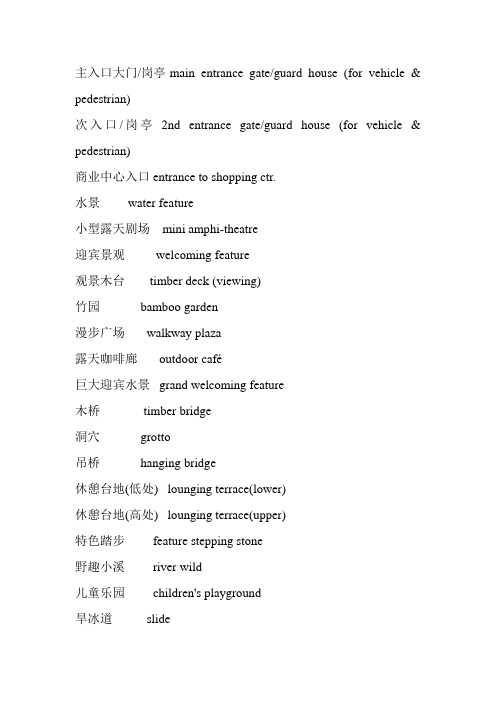
主入口大门/岗亭main entrance gate/guard house (for vehicle & pedestrian)次入口/岗亭2nd entrance gate/guard house (for vehicle & pedestrian)商业中心入口entrance to shopping ctr.水景water feature小型露天剧场mini amphi-theatre迎宾景观welcoming feature观景木台timber deck (viewing)竹园bamboo garden漫步广场walkway plaza露天咖啡廊outdoor café巨大迎宾水景grand welcoming feature木桥timber bridge洞穴grotto吊桥hanging bridge休憩台地(低处) lounging terrace(lower)休憩台地(高处) lounging terrace(upper)特色踏步feature stepping stone野趣小溪river wild儿童乐园children's playground旱冰道slide羽毛球场badminton court旱景dry landscape日艺园Japanese garden旱喷泉dry fountain观景台viewing deck游泳池swimming pool嬉水池wading pool儿童泳池 children's pool蜿蜒水墙 winding wall石景雕塑rock sculpture中心广场 central plaza健身广场 exercise plaza桥bridge交流广场 meditating plaza趣味树阵tree battle formation停车场 parking area特色花架trellis雕塑小道sculpture trail(高尔夫)轻击区putting green高尔夫球会所golf clubhouse每栋建筑入口entrance paving to unit 篮球场basketball court网球场tennis court阶梯坐台 terracing seat wall广场main plaza森林forest garden石景园 rockery garden旱溪dry stream凉亭Pavilion户外淋浴outdoor shower拉膜结构tensile structure台阶stair高尔夫球车停车场parking(golf car)健身站exercise station晨跑小路jogging footpath车道/人行道driveway/sidewalk人行漫步道promenade瀑布及跳舞喷泉(入口广场) water fall and dancing fountain (entry plaza)特色入口entry feature石景广场rockery plaza园林学Landscape architecture garden architecture造园学Garden making, landscape gardening环境园艺学Environmental horticulture观赏园艺学Ornamental horticulture园林艺术garden art园林美学Garden aesthetics园林建筑学Garden architecture园林建筑Garden building园林工程Garden engineering园林植物Landscape plant观赏植物Ornamental plant盆景Miniature landscape, penjing园林Garden and park园林学史History Of garden architecture园林规划Garden planning,landscaping planning 园林设计Garden design园林机具设备Gardening machine园林管理Garden management园林生态Landscape ecology绿化greening,planting环境绿化Environmental greening绿地面积Green area绿地率Ratio Of green space城市绿化覆盖率Urban Green coverage工厂绿化Factory greening,factory garden-ing 街道绿化Street greening,street planting车行道绿化Driveway greening分车带绿化Dividing Stripe greening人行道绿化Sidewalk greening群众绿化Mass Planting movement郊区绿化Suburban greening公路绿化Highway greening铁路绿化Railway greening,railway planting堤岸种植Bank planting阳台绿化Balcony greening窗台绿化window-sill greening屋顶绿化Roof greening垂直绿化Vertical greening攀缘绿化Climber greening桥头绿化Bridgehead greening花园garden专类花园Specified flower garden花园村Garden village园林城市Landscape garden city蔷薇园Rose garden松柏园Conifer garden球根园Bulb garden宿根园Perennial garden假山园Rock garden,Chinese rockery狩猎场Hunting ground街心花园Street crossing center garden小游园Petty Street garden水景园Water garden铺地园Paved garden野趣园Wild plants botanical garden野生植物园Wild plants garden乡趣园Rustic garden盆景园Penjing garden,miniature land-scape 动物园zoo,zoological garden墓园Cemetery garden沼泽园Bog and marsh garden水生植物园Aquatic plants garden学校园School garden室内花园Indoor garden芳香花园Fragrant garden盲人花园Garden for the blind公园park,Public park城市公园City park,urban park儿童公园Children park体育公园Sports park森林公园Forest park纪念公园Memorial park烈士纪念公园Martyr memorial park综合公园Comprehensive park文化公园Cultural park文化休憩公园Cultural and recreation park 中央公园Central park天然公园Natural park海滨公园Seaside park,seabeach park古迹公园Historic site park河滨公园Riverside park湖滨公园Lakeside park路边公园Roadside park,street park娱乐公园Amusement park雕塑公园Sculpture park休憩公园Recreation park疗养公园Sanatorium park国家公园National park邻里公园Neighborhood park植物园Botanical garden植物公园abeled plants park高山植物园alpine garden热带植物园tropical plants garden药用植物园medical plants garden,herb garden绿地green space公共绿地Public green space单位绿地Unit green area城市绿地Urban green space街道广场绿地Street and square green area居住区绿地Residential quarter green area防护绿地Green area for environmental protection郊区绿地Suburban green space街坊绿地Residential block green belt附属绿地Attached green space生产绿地Productive plantation area苗圃nursery风景landscape,scenery自然景观Natural landscape人文景观Human landscape,scenery of humanities草原景观Prairie landscape山岳景观Mountain landscape,alpine landscape 地理景观Geographical landscape湖泊景观Lake view郊区景观Suburban landscape地质景观Geological landscape喀斯特景观Karst landscape植物景观Plants landscape,flora landscape中国古典园林Classical Chinese garden中国传统园林Traditional Chinese garden中国古代园林Ancient Chinese garden中国山水园Chinese mountain and water garden 帝王宫苑Imperial palace garden皇家园林Royal garden私家园林Private garden江南园林Garden on the Yangtze Delta西方古典园林Western classical garden英国式园林English style garden中英混合式园林Anglo-Chinese style garden意大利式园林Italian style garden西班牙式园林Spanish style garden法兰西式园林French style garden勒诺特尔式园林Le-Notre's style garden文艺复兴庄园Renaissance style villa洛可可式园林Rococo style garden园林专业词汇2巴洛克式园林Baroque style garden庄园manor,villa garden廊柱园Peristyle garden,patio绿廊xystus迷阵maze,labyrinth灵囿Ling You Hunting Garden灵沼Ling Zhao Water Garden灵台Ling Tai Platform Garden阿房宫E-Pang Palace上林苑Shang-Lin Yuan未央宫Wei-Yang Palace洛阳宫Luoyang Palace华清官Hua-Qing Palace艮岳Gen Yue Imperial Garden圆明园Yuan-Ming Yuan Imperial Garden颐和园Yi-He Yuan Imperial Garden,Summer Palace 承德避暑山庄Chengde Imperial Summer Resort苏州园林Suzhou traditional garden悬园Hanging Garden英国皇家植物园Royal Botanical Garden, Kew garden凡尔赛宫苑Versailles Palace Park枫丹白露宫园Fontainebleau Palace Garden 景view,scenery,feature远景Distant view近景Nearby view障景Obstructive scenery,blocking view借景Borrowed scenery,view borrowing对景Opposite scenery,view in opposite place缩景Miniature scenery,abbreviated scenery漏景Leaking through scenery框景Enframed scenery尾景Terminal feature主景Main feature副景Secondary feature配景Objective view夹景Vista line,vista前景Front view背景background景序Order of sceneries景点Feature spot,view spot仰视景观Upward landscape俯视景观Downward landscape季相景观Seasonal phenomena气象景观Meteorological diversity scenery 视野Visual field秋色Fall color,autumn color园林空间Garden space开敞空间Wide open space, wide space封闭空间Enclosure space意境artistic conception,poetic imagery 苍古antiquity空灵spaciousness,airiness动观in-motion viewing静观in-position viewing视错觉Visual illusion园林艺术布局Artistic layout of garden对称平衡Symmetrical balance不对称平衡Asymmetrical balance左右对称Bilateral symmetry辐射对称Radial symmetry透景线Perspective line轴线axis,axial line主轴Main axis副轴Auxiliary axis暗轴Hidden axis,invisible axis树冠线skyline园林色彩艺术Art of garden colors单色谐调Monochromatic harmony复色谐调Compound chromatic harmony对比色突出Contrast colors accent近似色谐调Approximate colors harmony暖色Warm color冷色Cool color色感Color sense城市绿地系统规划Urban green space system planning 绿地系统Green space system公共绿地定额Public green space quota公共绿地指标Public green space norm绿地布局Green space layout吸引圈Attractive circle吸引距离Attractive distance有效半径Effective radius绿地资源Green space resource绿地效果Green space effect绿地规划程序Planning procedure of the green space 空间规划Space planning形象规划Image plan实施规划Implementary plan必要生活空间Necessary living space余暇生活空间Leisure time living space利用频度Usage frequency树种规划Planning of trees and shrubs绿地类型Typeof green space环状绿型Annular green space块状绿地Green plot点状绿地Green spot放射状绿地Radiate green space楔状绿地wedge-shaped green space缓冲绿地Buffer green space防音绿地Noiseproof green space科学景观论Scientific landscape theory园林保留地Reserve garden公园规划park planning园林总体规划Garden master planning总平面规划Site planning园林分区Garden zoning安静休息区Tranquil rest area儿童活动区Children playing space儿童游戏场Children playground, playlot体育运动区Sports activities area野餐区Picnic place散步区Pedestrian space群众集会区Mass meeting square观赏植物区Ornamental plants area观赏温室区Display greenhouse area, display conservatory area草坪区Lawn space绿荫区Shade tree section历史古迹区Historical relics area青少年活动区Youngsters activities area诱鸟区Bird sanctuary area钓鱼区Fishing center野营区Camp site游人中心Visitors center服务中心Service center探险游乐场Adventure ground文化活动区Cultural activities area道路系统Approach system, road system 环形道路系统Circular road system方格形道路系统Latticed road system放射形道路系统Radiate road system自然式道路系统Informal road system规整式道路系统Formal road system混合式道路系统Mixed style road system园林规划图Garden planning map园林规划说明书Garden planning direction 城市公园系统Urban park system公园分布Distribution of parks公园类型Park type, park category公园间距Distance between parks公园形式Park styles游览区Excursion area, open-to-public area非游览区no-admittance area办公区Administrative area服务区Service center动休息区Dynamic rest space静休息区Static rest space娱乐演出区Entertaining performance place 主要入口Main entrance次要入口Secondary entrance人流量Visitors flowrate车流量Vehicle flowrate公园道路parkroad公园水陆面积比率land-water ratio游人容纳量Visitors capacity风景资源调查Landscape resource evaluation风景学scenicology风景规划Landscape plan风景设计Landscape design游览路线Touring route旅游资源Tourism resource旅游地理Tourism geography旅游地质Tourism geology历史名城Famous historical city文化名城Famous cultural city文化遗址Ancient cultural relic天然博物馆Natural open museum风景地貌naturalgeomorphology造型地貌imaginative geomorphologic figuration 风景区Scenic spot, scenic area风景名胜Famous scenery, famous scenic site特异景观风景区Specific natural scenes area民族风俗风景区Scenic spot of minority customs高山风景区Alpine scenic spot海滨风景区Seabeach scenic spot森林风景区Forest scenic spot高山草甸风景区Alpine tundra landscape spot峡谷风景区Valley scenic spot江河风景区River landscape district湖泊风景区Lake round scenic spot温泉风景区Hot spring scenic spot瀑布风景区Waterfall scenic spot禁伐禁猎区Region forbidden to tree cutting and hunting 封山育林区Region closed for afforestation天池风景区Crater lake scenic spot自然保护区Nature protection area科学保护区Protection area for scientific research天然纪念物Natural monument生物圈保护区Biosphere protection area园林设计师Landscape architect, garden designer园址测量图Garden site survey map地形图Topographic map, contour map种植设计Planting design地形改造设计Topographical reform design 种植大样图detailplanting design造价分析Cost analysis园林形式Garden style规整式园林Formal garden style非规整园林Informal garden style几何式园林Geometric garden style。
日本园林简介

A Japanese garden
一、日本园林历史 二、园林特点 三、 构景原则
Japanese garden history
• 六世纪,中国园林随佛教传入日 本 (The sixth century, Chinese gardens with Buddhism was introduced into Japan) 借鉴中国园林,往往抓住某 个方面而倾力以注,或广袤, 或幽邃,或开朗,或深沉 (Reference to Chinese gardens, tend to grab a certain aspect and exert to note, or the vast, or YouSui, or cheerful, or dark)
•
尊石 精致
tea茶道 tea茶道
Constitutive scene principle
• 有自己的园林思想 • 与本土文化 协调 • 环境scape characteristics)
• 园林规模简洁、凝缩; • 园中水域极少; • 日本人尊奉的石 多运用园中; • 追求“净、空、无” • 纯净细致 枯山水” “枯山水”
• 极精致、极正式; • 每块步石的设置都 有特定用意(如主 人石、客人石、刀 挂石等) 每株植物、室外家具 (如石灯笼、石水钵 ), 体现贵族完美的追求 “茶室庭园“ 茶室庭园“
园博园之旅英文作文
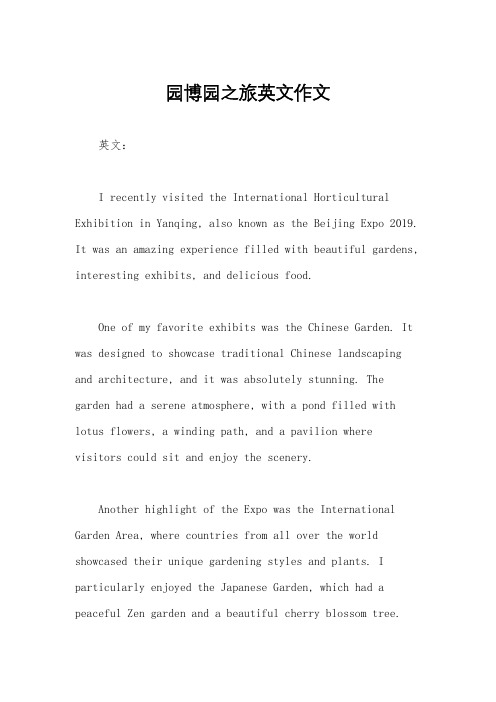
园博园之旅英文作文英文:I recently visited the International Horticultural Exhibition in Yanqing, also known as the Beijing Expo 2019. It was an amazing experience filled with beautiful gardens, interesting exhibits, and delicious food.One of my favorite exhibits was the Chinese Garden. It was designed to showcase traditional Chinese landscaping and architecture, and it was absolutely stunning. The garden had a serene atmosphere, with a pond filled with lotus flowers, a winding path, and a pavilion wherevisitors could sit and enjoy the scenery.Another highlight of the Expo was the International Garden Area, where countries from all over the world showcased their unique gardening styles and plants. I particularly enjoyed the Japanese Garden, which had a peaceful Zen garden and a beautiful cherry blossom tree.Aside from the gardens, there were also manyinteresting exhibits on display. One exhibit that stood out to me was the "Green City" exhibit, which showcased innovative solutions for creating sustainable cities. It was inspiring to see how much progress has been made inthis area.Of course, no trip to the Expo would be complete without trying some of the delicious food on offer. There were many food stalls selling traditional Chinese snacks and dishes, as well as international cuisine. I tried some amazing dumplings and noodles, and also had some delicious Thai food.Overall, my trip to the Yanqing Expo was a wonderful experience. I learned a lot about gardening and sustainability, and also had a lot of fun exploring the different exhibits and gardens.中文:我最近参观了北京世园会,也就是延庆国际园林博览会。
日本庭园
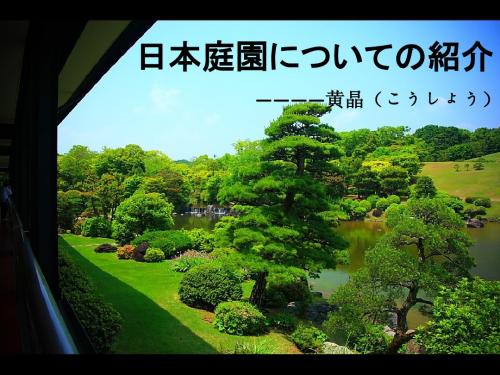
日本庭園は概して三種類に分けられる
観賞式
の
種
Ⅰ. 池泉庭園
枯水山庭園 Ⅱ.
回遊式
舟遊式
﹡
﹡
Ⅲ . (茶庭) 露地
﹡
池を中心 とした構成 の池泉庭園 である。
枯水山庭园
水や緑を使 わず、岩や砂 などで山や水 の風景を表現 する枯山水庭 園である。
露地(茶庭) 露地とも言 われ茶の座敷 へと向かう細 い通路に海や 山の風景を表 現した茶庭
日本庭園についての紹介
————黄晶(こうしょう)
日本庭園とは、日本の伝統的な庭園であ る。和風庭園ともいう。
﹡
日本庭園
﹡
特徴:
⊙ 日本伝統文化の典型だ ⊙ 歴史の深い遺産だ。 ⊙ 発展ソースは中国の庭園だ。 ⊙ 山と水の方面で池、磯と須弥山など、
動物の方面で亀、魚、犬と馬など、 建築の方面で苑、離宮、がぼうなど、 庭園に遊ぶ方面で狩りをする、舟遊、其水 宴などの内容を含んでいる
※
〓
日本の有名な三大庭園
※
兼六园(石川县金泽市)
〓
※ 后楽园(冈山県冈山市)
〓
偕楽园(茨城県水戸市)
※
兼六园(石川县金泽市)
后楽园(冈山県冈山市)
偕楽园(茨城県水戸市)
じゃ
ありがとうございます
終り
日本传统建筑和花园 (11)
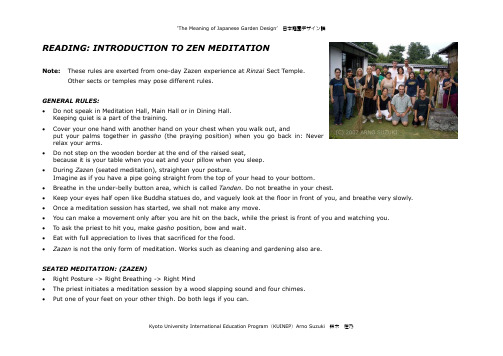
Note:These rules are exerted from one-day Zazen experience at Rinzai Sect Temple.Other sects or temples may pose different rules.GENERAL RULES:∙Do not speak in Meditation Hall, Main Hall or in Dining Hall.Keeping quiet is a part of the training.∙Cover your one hand with another hand on your chest when you walk out, andput your palms together in gassho(the praying position) when you go back in:Neverrelax your arms.∙Do not step on the wooden border at the end of the raised seat,because it is your table when you eat and your pillow when you sleep.∙During Zazen (seated meditation), straighten your posture.Imagine as if you have a pipe going straight from the top of your head to your bottom.∙Breathe in the under-belly button area, which is called Tanden. Do not breathe in your chest.∙Keep your eyes half open like Buddha statues do, and vaguely look at the floor in front of you, and breathe very slowly.∙Once a meditation session has started, we shall not make any move.∙You can make a movement only after you are hit on the back, while the priest is front of you and watching you.∙To ask the priest to hit you, make gasho position, bow and wait.∙Eat with full appreciation to lives that sacrificed for the food.∙Zazen is not the only form of meditation. Works such as cleaning and gardening also are.SEATED MEDITATION: (ZAZEN)∙Right Posture -> Right Breathing -> Right Mind∙The priest initiates a meditation session by a wood slapping sound and four chimes.∙Put one of your feet on your other thigh. Do both legs if you can.∙Straighten your posture. Imagine as if you have a pipe going straight from the top of your head to your bottom. Imagine that anything thrown into the pipe would go straight down to the bottom.∙Hold your left thumb with your right hand, cover your right hand with your left hand and place both hands as they are under your belly button. (Circle-like hand position as seen in the illustration is suited for more advanced practitioners.)∙The under-belly button point is called Tanden, which is where you breathe. Do not breathe in your chest.∙Keep your eyes half open (Hangan) like Buddha statues do, and vaguely look at the floor about 4-5 feet ahead of you.∙Breathe slowly: Experienced priests can breathe as slowly as twice a minute. (Note: The lecture of the older priest was about the importance of breathing right for the most part).∙Count your breathing from one to ten, and then go back to one and repeat it: when your mind does not focus, you tend to count more than ten or lose the number before you reach ten.∙Once a meditation session has started, we shall not make a move even if you have a runny nose or a mosquito bite.∙If you need to change your position or change legs, ask the priest to hit your back with a bamboo stick (Keisoku). You can make a movement only after you are hit on the back, while the priest is standing in front of you and watching you.∙To ask to be hit by the Keisoku, do gassho when the priest approaches you. Once he has stopped in front of you, bow in gassho position, then bow lower with your arms crossed under your chest to show your back, and wait.∙The priest first knock on the left side of your back and then hit it harder twice. Next he will do the same to the right side of your back.He will hit right on the spot so that it would not injure you or leave you with a pain. So, do not be afraid.∙Gassho and raihai (meaning “thank you”) to show your appreciation to the priest after he hits you.∙ A meditation session lasts for a length while a piece of incense burns out, which is about 30 minutes.∙The end of a session will be also announced by the chime, and the priest will say, “Niben Orai”, which means “you may go to the restroom now”.∙During the meditation session, the priest may come to hit you by his decision. When he stops at you and knocks on your shoulder lightly with his bamboo stick, get ready position to be hit.∙There are four occasions when the priest decides to hit you when:You look too tight or nervous -> to loosen you upYou look sleepy -> to wake you upYou are losing focus -> to remind you what you are doingYou are doing great -> to remind you can be even better∙After the meditation session in the morning, you’ll walk around the hall to relax your legs and to go to restroom without interruption.BREAKFAST MEDITATION: (KAYU-ZA)∙Always keep the bowls and plates in the same order (from left to right, porridge, sub-dish, pickles and chopsticks).∙The chopsticks should be placed with their tips sticking out of the table edge toward you so that they would not mess the table.∙When porridge servers comes, put the rice bowl onto their palm with your both hand. Watch how much they pour and scrape your hands to make a sound to notify them to stop.∙While porridge is being served, chant the “Hannya-shin-gyo” sutra.∙Before you start eating, take five to seven pieces of rice at the other edge of the table from you: This is an offering to all living creatures and will be collected by the scrapers and offered to birds later.∙Before start eating, we swear five things (in the sutra booklet):∙We thank all others who have contributed to bring this food in and all lives sacrificed to make this food.∙We deeply appreciate that we have this food here, although we are so imperfect that we do not deserve such food yet.∙While eating, we will not have any greed or dislike of food.∙We are aware of that this food is a medicine to make our lives longer and healthier.∙We swear to work hard and do good things in exchange for the food we are consuming.∙While eating, never make any noise even when you bite those crunchy pickles and place the dishes on the table. This is because eating quietly is more polite and because we should not damage dishes and tables too much.∙Hold each bowl or dish when you eat; e.g. you should not extend your chopsticks to the pickles while holding the rice bowl. (This is a general manner for the traditional Japanese cuisine).∙Leave one pickle so that we can use it for cleaning the dishes later.∙When rice refill servers come, everyone should stop eating and wait for the refill to be served to everyone. If you want a refill, gassho without bowing. If you don’t want a refill, bow with your hands on your thighs.∙We should not leave any food. Take only what you can eat.∙If you would like the server to pour the porridge slowly, rub your hands, and then scrape your hands to stop him/her.∙When the bucket comes, throw your plum seed quietly into it.∙When the tea servers come, hold up your rice bowl to receive the tea. Three people should hold up bowls closer so that tea can be served easily and quickly.∙Using your finger, dampen the rice offering mark on your table with a little bit of tea so that the table can be cleaned easily.∙Use your chopsticks as a guide; pour some tea into two other plates. After washing the plates with the slice of pickles, and drain the tea back into the rice bowl (it will help the dish washing).∙Eat the pickle quietly, and drink up the tea, which now taste like a cup of soup. (We should not throw any food).∙Put two plates into the rice bowl (sub-dish plate on top, pickle plate at the bottom). Put them away when the collectors come.∙Put away tables as quickly as you can.∙Leave the dining hall in a row in the same order.CONVERSATION WITH ZEN PRIESTS AFTER THE SESSION:Q: How do you become a priest?A: Buddhist priests were not allowed to get married before, until about 100 years ago. At that time, there were many surplus children in Japan and they were often given to a temple, where they worked and get trained to be a priest. In later time, there came fewer children therefore temples got short of successors, priests began to be allowed to marry so that they can make their own children to take over our temple. Nowadays, a priest’s child can choose a different profession, or people from common family can become a priest.Q: Do priests have holidays?A: While we are in training, which usually lasts six to ten years, we are not allowed to go out of the temple therefore have no holidays. We are basically repeating all day what you experienced for one night. Even after we get a job, most of priests have to have a second job to make living, therefore we don’t have days off very often. Think twice if you want to have a priest boyfriend.Q: Why are some priests so fat if you eat such healthy meals?A:It is OK for the priests to eat meat and fish in Japan. (Don’t translate this into English because we do not smear other people’s dreams!). However, we are not allowed to leave, or waste, any food because this is to waste another’s life. That is, we have to eat everything served. When we visit people’s home to pray for their ancestor and so on, they treat us nicely with a lot of food. That’s why some of us get really big.Q: What is enlightenment?A:Personally I cannot answer because I have not got one yet. However, I suppose enlightenment is to find, or realize, a little new something in your everyday life.。
- 1、下载文档前请自行甄别文档内容的完整性,平台不提供额外的编辑、内容补充、找答案等附加服务。
- 2、"仅部分预览"的文档,不可在线预览部分如存在完整性等问题,可反馈申请退款(可完整预览的文档不适用该条件!)。
- 3、如文档侵犯您的权益,请联系客服反馈,我们会尽快为您处理(人工客服工作时间:9:00-18:30)。
Styles—— Dry Rock Gardens(karesansui )
• Dry Rock Gardens or Zen Gardens often have white sand or raked gravel in place of water, carefully arranged rocks, and sometimes rocks and sand covered with moss. Their purpose is to facilitate meditation, and they are meant to be viewed while seated on the porch of the residence.
Design Elements
• • • • • • • Water Rock and sand Garden architectures Garden bridges Stone lanterns and water basins Garden fences, gates, and devices Plants
Chinese Gardens Japanese Gardens
elaborate, with much ornament, simple, with very little Architecture occupying a large part of the decoration garden space Viewpoint designed to be seen from the inside, from the buildings and pavilions in the center of the garden rocks were selected for their extraordinary shapes or resemblance to animals or mountains designed to be seen from the outside,or from a path winding through the garden rocks were smaller and placed in more natural arrangements integrated into the garden
Use of Rocks
Thank you for attention!
Landscape Gardens
Japanese Gardens
姓名 2013.3.13
Brief Introduction
• Japanese gardens are traditional gardens that create miniature idealized landscapes, often in a highly abstract and stylized way.The gardens of the Emperors and nobles were designed for recreation and aesthetic pleasure, while the gardens of Buddhist temples were designed for contemplation and meditation. They were developed under the influences of Chinese gardens,but gradually Japanese garden designers began to develop their own aesthetics, based on Japanese materials and Japanese culture.
Phoenix Hall of Byōdō-in Temple
The arching bridge
Styles——Tea Gardens(roji茶庭)
• The style of garden takes its name from the path to the teahouse,which is always kept moist and green. There is an outer garden, with a gate and covered arbor where guests wait for the invitation to enter. Then they pass through a gate to the inner garden, where they wash their hands and rinse their mouth, preparing themself for the ceremony and meditation.
Traditional teahouse at the Rustic gate of the tea garden Kenroku-en Garden(兼六园)
Styles——Promenade Gardens(kaiyū-shiki-teien )
• These gardens are meant to be seen by following a path clockwise around the lake from one composed scene to another. They used two techniques to provide interest. • 1. Borrowed scenery(借景) which took advantage of views of scenery outside the garden, such as mountains or temples. • 2. Hide-and-reveal(隐趣) which used winding paths, fences, bamboo and buildings to hide the scenery so the visitor would not see it until he was at the best view point.
Heian-jingū 神宫
Daikakuji Temple 大觉寺
Styles——The Paradise Garden(净土庭院)
• The Paradise Garden was created by nobles belonging to Buddhism,meant to symbolize the Pure Land (极乐净土), where the Buddha sat on a platform contemplating in a lotus pond. These gardens featured a lake island, where the Buddha hall was located, connected to the shore by an arching bridge.
Shugaku-in Imperial Villa(修道院离宫)
Two hills represent Mount Lu in China
Styles——Courtyard Gardens(tsubo-niwa)
• These small gardens were designed to give a glimpse of nature and some privacy to the residents of the rear side of the building. These tiny gardens were meant to be seen, not entered, and usually had a stone lantern, a water basin, stepping stones and a few plants.
Styles
• Along with the development of history,Japanese gardens have formed several different styles and types.
• • • • • • •
Dry Rock Gardens(karesansui 枯山水) Pond Gardens (Chisen-shoyū-teien 池泉园) The Paradise Gardens(净土庭院) Tea Gardens(roji 茶庭) Promenade Gardens(kaiyū-shiki-teien 漫步花园) Courtyard Gardens(tsubo-niwa) Hermitage gardens(隐士园林)
Characteristics
• It is said that the Japanese generate “the best of nature„s handiwork in a limited space.”Some basic characteristics and principles are: • Miniaturization 微型. The Japanese garden is a miniature and idealized view of nature. Rocks can represent mountains, and ponds can represent seas. • Concealment 隐趣. Features are hidden behind hills, trees, groves or bamboo, walls or structures, to be discovered when the visitor follows the winding path. • “Borrowed” Scenery 借景.Smaller gardens are often designed to incorporate the view of features outside the garden as part of the view,which makes the garden seem larger than it really is. • Asymmetry 不对称. Japanese gardens are not laid on straight axes, or with a single feature dominating the view.
